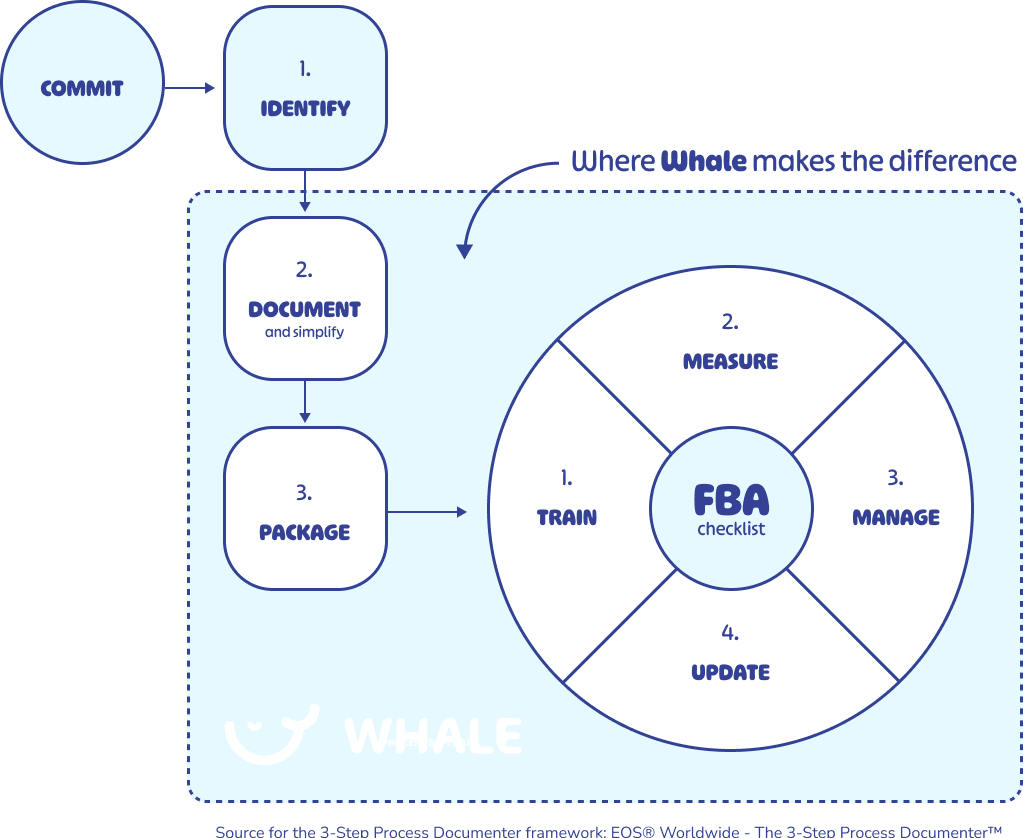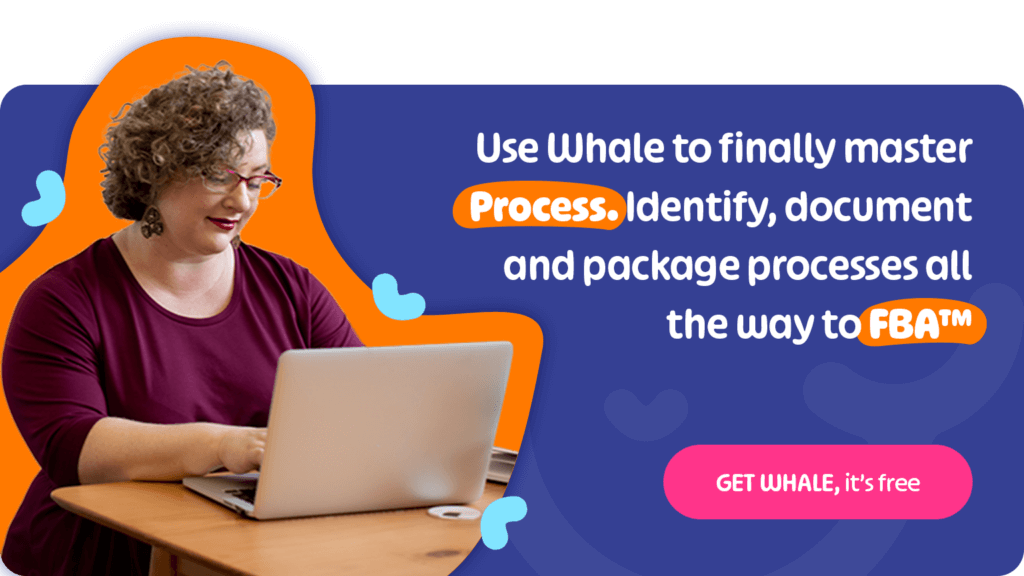Introduction
For companies that use the Entrepreneurial Operating System® (EOS Model®), you’ll probably recognize that the Process component is one of the most neglected parts of any business that is struggling to grow.
There’s absolutely no point in creating new processes for your business if they’re not followed by all your staff. In this article, we’ll give you all the tips and tricks for how you can ensure your processes are not just followed by all, but LOVED by all.
Why do you need people to follow processes?
Let’s start from the beginning – why do people actually need to follow processes within your business?
Consistency
Processes ensure that tasks and activities are performed consistently, reducing the likelihood of errors or oversights. Consistency is essential for maintaining quality and meeting customer expectations.
Efficiency
Well-defined processes streamline workflows, eliminating unnecessary steps and bottlenecks. This efficiency translates into time and cost savings, allowing resources to be utilized more effectively.
Scalability
As businesses grow, the demand for consistent and efficient operations increases. Processes provide a scalable framework, allowing companies to handle larger volumes of work without sacrificing quality or effectiveness.
Accountability
Clearly defined processes help establish accountability within a team. Each individual knows their role and responsibilities, reducing confusion and fostering a sense of ownership over tasks.
Adaptability
Processes can be designed to be flexible, allowing businesses to adapt to changing market conditions, new technologies, or shifts in customer preferences. This adaptability is crucial for staying competitive in dynamic environments.
The aim is for your processes to be ‘Followed by All’ (FBA). This isn’t just a checkbox exercise, it’s a commitment embraced by every member of the team. It represents a shared dedication to excellence, where every individual understands the importance of adhering to established procedures.
And it’s a crucial element to helping you scale and grow your business.

Why do people struggle to follow processes?
Even though we all know that following processes will give us the best results, let’s be honest, it doesn’t always happen. There are a number of reasons why this could be…
❌ They’re resistant to change
❌ They don’t understand the need for it
❌ The processes aren’t clearly defined
❌ They don’t agree with how the process has been set up
❌ They haven’t had adequate training
❌ There’s a lack of accountability
❌ It’s BORING
But don’t worry! Just because things aren’t working at the moment doesn’t mean you can’t turn things around. All you need is a bit of process magic ✨
How to get your team to not just follow, but LOVE, processes?
More than 50% of organizations are looking to improve their business processes, recognizing that they perform better when their processes are aligned with overall organizational objectives.
And when it comes to getting your team to follow processes, it’s all about making it engaging for them.
The aim isn’t just to throw a load of new processes at them and hope for the best, you want them to be involved at every step – from identifying areas that need improvement, to designing the processes and getting them trained out to the wider team.
The more involved they feel, the more likely they are to champion your new processes🏆

We’ll get on to our FBA checklist shortly, but first, let’s take a look at some of the key things you need to remember when setting out your new and improved processes.
Start with Why
It’s important to start by clearly explaining to your team why you’re updating your processes, why they need to adhere to them and what benefits it will have for them (and the business!) Make them see how beneficial it will be to their working lives.
Celebrate
If things are going well – celebrate it! Recognize the achievements you make as a team and give everyone the kudos they deserve for a job well done. Acknowledgment, incentives, or even a simple thank-you can go a long way in boosting morale and motivation.
Lead by example
As a leader, you have a crucial role in making sure your team follows processes. When leaders prioritize and follow processes, it sets a precedent for others to do the same. You gotta lead by example!
There’s nothing worse than a leader who instructs people to do what they say but acts entirely different!
The FBA chcklist you need
Train
Make sure that every person who touches the process is involved in thorough training, explaining how it will work and how it will affect them. This should be made as engaging and fun as possible.
Make sure you give them the opportunity to feed back and get involved in creating the processes, highlighting specific areas for improvement and their suggestions on how to get the best results.
Measure
Make sure you’re keeping track of the changes that your new processes are having. A great way to do this is to track:
- Compliance (whether people are following the processes)
- Frequency (whether they’re doing it often enough to make traction)
- Outcomes (whether they’re getting the right results)
With this information, you can provide feedback to your team on where they can make improvements to get consistently good results.
Manage
While you may still find push back on your new processes – don’t worry, this is totally normal. But it’s important to make sure that their feedback is heard and that you offer to make changes that incorporate this wherever possible. You want everyone to be on board with your processes!
Update
This isn’t a one-time process – it’s a continuous circle of improvement. Create a feedback loop where employees can provide input on processes and actively seek suggestions for improvement. Make sure you demonstrate a commitment to making adjustments based on the feedback you get.
How can technology help to ensure your processes are followed?
The EOS 3-Step Process Documenter™ is a tool that helps you work backwards from a desired outcome and define the major steps in the process. And while it is a great method for helping you identify and update the necessary processes, it can be time consuming.
But this is where Whale comes in.

Let’s remind ourselves of what the 3-Step Process Documenter™ involves, and where Whale can provide value to your team when executing it.
Step 1: Identify
List out the handful of core processes that make your business successful. Remember, you just need to document the 20% of processes that get you 80% of the results you need.
💡 ACTION STEP
Whale helps you do this with a selection of core process templates to get started. Take a look at our full template gallery.
Step 2: Document
Now that you have identified your core processes in the form of a short list, it’s time to think about HOW you want to document them.
With a pen and paper? Or digitally?
While a pen and paper still has its role in writing letters to loved ones, we’d strongly recommend going down the digital route for business processes.
There are a range of digital options, from simply using Google Docs or Word to using more advanced platforms. However, to truly bring The 3-Step Process Documenter to life, you will need a platform like Whale in order to have your processes FBA.
💡 ACTION STEP
Take each of those core processes and document them in just a few minutes with our AI Assist tool.
Step 3: Package
“Documenting your processes will ensure they’re followed by all.”
But HOW do you want to document them?
- In a simple text document
- As a checklist to be accessed on a smartphone or tablet
- Using a video?
Creating engaging documentation is essential to having your processes followed. If Netflix can do it, so can you!
💡 ACTION STEP
Whale will help you centralize all your company-specific processes and share them with your teams.
With automated flows, you can do this automatically so that your teams get the information they need when they need.
Learn more about why Whale is the perfect companion for EOS processes.
Bottom line
Adhering to well-defined processes is crucial for companies operating under the EOS model to achieve sustained success.
And when it comes to making things work smoothly, it’s all about how you put your new processes into action. How are you telling everyone about them? How are you putting them together? Are the right people in on it? Get these things right, and you’re steering your team in the direction of a well-oiled machine where things not only get done but get done together.
Embracing these practices not only fortifies your commitment to the EOS model but also paves the way for increased efficiency, improved outcomes, and long-term success for your business.
So, why not bite the bullet and give our FBA method a go!
TL:DR
- Process component is one of the most neglected parts of any business that is struggling to grow.
- You need people to follow your processes for efficiency, consistency and growth.
- To have your processes followed by all (FBA), make sure your teams understand the why. Also celebrate team members and lead by example.
- The FBA checklist you need is train, measure, manage and update.
- Whale helps you identify, document and package your processes in no time.







